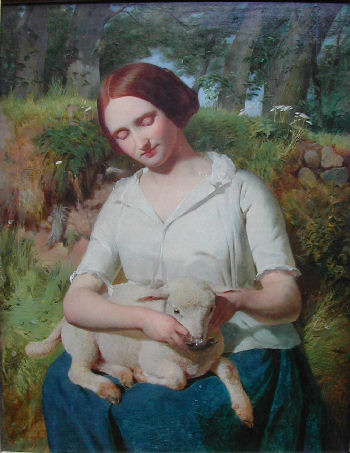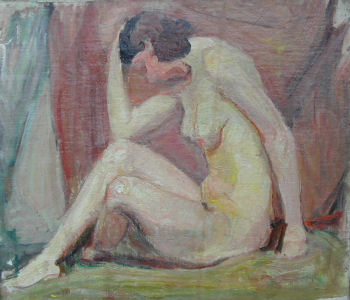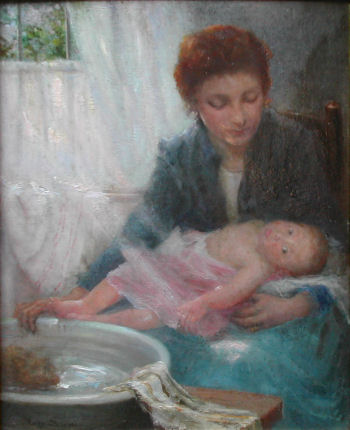Oil on Canvas, 13x17cm.
Stirling 1820 – 1871
Provenance: Exhibited at the Royal Academy 1853.
John Stirling first exhibited three portraits at the Royal Academy in 1852. In the same year Holman Hunt’s masterpiece ‘The Hireling Shepherd’ was hung in the Academy and it is more than likely that John Stirling would have seen the work of the Pre-Raphaelites for the first time on a visit to London from Aberdeen to see his own work hung.
The work of the Pre-Raphaelites was first seen in 1849 and the brotherhood existed for a period of about five years from that date.
It seems certain that John Stirling was impressed by the work of the Pre-Raphaelites and was influenced by them when he produced his painting ‘The Lassie and the Lamb’, which was exhibited at the Academy in 1853. The technique used by such artists as Holman Hunt and Millais was to paint in pure colour on a white, wet ground which produced a distinctive luminosity as was a technique Stirling also employed in ‘The Lassie and the Lamb’. Similarly, the Pre-Raphaelite’s great attention to detail and most particularly in the cases of Hunt and Millais, their wish to reflect nature accurately is reflected in John Stirling’s painting.
While the Pre-Raphaelite Brotherhood was not without its detractors, Charles Dickens for one, its great champion was the foremost Victorian critic and painter John Ruskin. He took notice of the work of John Stirling and in ‘Academy Notes’ of 1855 commented on Stirling’s Academy painting: ‘The Scottish Presbyterians’ describing it as ‘…a very acceptable picture, showing careful study and good discrimination.’
The title of the painting ‘The Lassie and the Lamb’ is taken from Wordsworth’s poem ‘The Pet Lamb’, a pastoral. In later works, the artist took poetry for a direct inspiration for his subjects which were the Pre-Raphaelite Brotherhood’s oeuvre.
The Pre-Raphaelites had a considerable influence on a number of painters and there can be little doubt that John Stirling’s painting ‘The Lassie and the Lamb’ falls safely into the Pre-Raphaelite category.
John Stirling exhibited his first works at the Royal Academy in 1852 and continued to exhibit there until 1871, the year he died. His first paintings were exhibited from an Aberdeen address, although it seems he also lived in London, since the pictures were sent both from Aberdeen and London during his active years.
A number of his later works are a result of his visits to Morocco in 1868 and 1869. His three exhibits at the Royal Academy in 1869 were ‘Al Sok’, a market in Morocco, ‘Repas Honnetre’ and Al-Ghirab, a water seller in Morocco.






